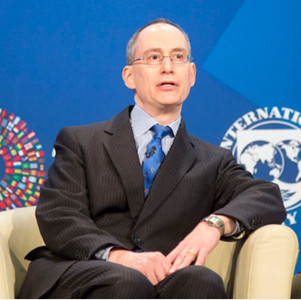Three Days at Camp David: How a Secret Meeting in 1971 Transformed the Global Economy
With the right policies, countries can pursue both objectives

With the global economy enjoying its broadest synchronized expansion since 2010, and further gains forecast for this year and next, it is tempting to conclude that economic dangers have receded and that a new normal of healthy growth is upon us. Of course, economists always see risks on the horizon, be they the buildup of financial vulnerabilities, trade protectionism, or various geopolitical calamities. One that is persistently in their sights is the risk that policymakers will grow complacent and fail to press on with the reforms needed to lay a foundation for sustained growth.
Economists have long believed that improving the supply side of the economy—reducing barriers to entry in product markets and making labor markets more flexible are notable examples—is the key to sustaining growth. That is why there is so much emphasis in IMF (and other) policy advice on removing impediments to the movement of goods and capital across borders and improving economic efficiency through liberalization and deregulation.
In work undertaken several years ago, we found strong support for the idea that structural reforms conferred sizable benefits for economic growth. Among the benefits, overseas companies invest more capital as the business environment improves, and local firms benefit from easier access to credit. Firms also shift capital to more productive uses as distortive subsidies and tariffs are removed, and their improved prospects are reflected in higher credit ratings, which allow them to borrow more cheaply. These same forces may also help make growth more durable—contributing to longer growth spells. This improvement in the sustainability of growth is critical: it is only when spells extend over many years or decades that per capita income gaps between developing and developed economies will close. Jump-starting growth is much easier and more common than sustaining durable growth.
Costs of inequality
Since the global financial crisis of 2008, however, economists and policymakers have begun to question whether supply-side policies alone can ensure sustained growth. They point to mounting evidence that growth tends to be more fragile and less resilient when it is not inclusive and its fruits accrue mainly to the wealthiest.
This could reflect the fact that—when adverse shocks occur—there is less support in unequal societies for the kinds of policies that help right the economic ship, because the short-term pain doesn’t bring broadly shared longer-term gains. It could also simply reflect the fact that these societies don’t offer equal access to education, health care, nutritious food, credit markets, and even the political process (equality of opportunity for short), making them less resilient in general.
Economists, including Raghuram Rajan and Joseph Stiglitz, have pointed to growing inequality in many countries as a prime cause of the 2008 crisis. My own work also found that the likelihood of succumbing to a severe downturn was greater in countries with high or rising inequality in the years and decades before the crisis (Berg and Ostry 2017). We argue (Ostry, Loungani, and Furceri 2018) that policymakers’ faith in their ability to get growth going through supply-side measures and deal with distributional issues later is a dangerous gamble, and that they should instead focus simultaneously on the size of the pie and its distribution. I call this a macro-distributional view for short.
Economics and economists (not just at the IMF, but generally) came under fire after the crisis because their models paid insufficient attention to linkages between finance and the real economy— between Wall Street and Main Street to use popular parlance, or macro-financial linkages in the jargon of economists. Yet in my view, insufficient attention to macro-distributional linkages, between the size of the pie and each household’s piece of the pie, was just as important. And while economists have emphasized the risk of secular stagnation (a prolonged deficiency in aggregate demand and negligible economic growth) in the wake of the crisis, the risk of secular exclusion (when growth accrues only to those at the top of the income distribution) in many countries is probably just as salient. If median incomes stagnate, and income polarization intensifies, there is even a risk of a vicious cycle between secular stagnation and exclusion as those at the bottom lack the resources to support demand and growth.
Implications for policy
Economists have generally frowned upon paying attention to distributional issues. This bias dates back at least to the publication in 1942 of Joseph Schumpeter’s Capitalism, Socialism, and Democracy and is evident also in the modern work of Nobel laureate Robert E. Lucas Jr., who wrote in 2003 that “Of the tendencies that are harmful to sound economics, the most seductive, and in my opinion the most poisonous, is to focus on questions of distribution.” The basis of this view is the so-called trickle-down theory, which holds that a rising tide lifts all boats, so that if growth is assured, there is no need to worry about distribution. But if healthy growth is undercut by excessive inequality, then even the policymaker who has no qualms about the moral or social implications of inequality should be concerned about the economic cost. The macro-distributional view has merit independent of the weight placed on inequality in the social welfare function, which links a society’s welfare to the aggregate size of the pie and its distribution.
The macro-distributional view has implications not only for the way economists look at growth but also for the policy advice we give. The reason is simple: rising inequality does not simply fall from the sky, nor is it caused entirely by technological change, which amounts to the same thing, since no one would seriously contemplate rolling back technical progress to curb inequality. Instead, as argued in Ostry, Loungani, and Berg (2018), it is driven to an important extent by the very policies that are the basic tools of the economist’s trade (Ostry, Berg, and Kotharti 2018). These include not only macroeconomic policies (think of the progressivity of the tax system, or infrastructure spending, or even monetary policy in terms of its impact on the prices of assets held mainly by the rich), but also the kinds of supply-enhancing policies discussed above. The implication is clear: when designing such policies, some assessment of their impact not only on the size of the pie, but on the distributional consequences, should be taken into consideration.
Winners and losers
A counterargument might be that supply-enhancing policy instruments must be geared to their primary targets, which is precisely to expand the size of the pie rather than worry about who wins and who loses. The rub is that such an approach may end up frustrating the very objective its proponents seek. Because reforms inevitably produce winners and losers, it is a fact of life that the opposition of the losers may end up frustrating the ability of politicians to enact reforms intended to boost the size of the pie. As European Commission President Jean-Claude Juncker famously noted, “We all know what to do; we just don’t know how to get reelected after we’ve done it.”
There is a tie-in with debates over globalization. Its goal is also to boost the size of the pie. But if those who face prolonged, unremediated dislocation from globalization end up opposing it and instead support politicians with nativist or protectionist agendas, the likely result will be neither a larger pie nor an equitable distribution. Once again, a macro-distributional view is essential, not only to avoid excessively unequal outcomes for moral or social reasons, but also to ensure that the policies promoting a growing pie aren’t abandoned in favor of protectionism.
If policies have a material impact on inequality, then this impact needs to be taken into account at the policy design phase. Of course, that is not the only solution, since it may be possible to remedy distributional outcomes afterward, with programs to redistribute income and wealth through taxation and transfers to offset the impact on the less advantaged (Ostry, Berg, and Tsangarides 2014). But history suggests that governments have found it difficult to undertake the needed redistribution in practice and, as a result, distributional effects of certain reforms and globalization policies have not been remedied. Knowing how and what to remedy requires having a handle at the outset on the equity and efficiency effects both of globalization and of reform policies.
Recent work with my colleagues has sought to assess the aggregate and distributional effects of aspects of globalization and structural reforms. We found that some structural reforms give rise to growth-equity trade-offs; for example, opening the economy to cross-border capital flows tends to increase both growth and inequality. The implication is not that distributional consequences should give license to roll back reforms or globalization, given their often-sizable aggregate benefits; rather, distributional effects should inform and ultimately improve the initial design of reform packages to better balance winners and losers. This is essential to give credibility to claims that gains from supply-enhancing reforms and globalization will end up being broadly shared. Policymakers can choose to design more inclusive supply-enhancing policies; one way is to ensure that the domestic financial sector is inclusive and well regulated, so that the benefits of external financial liberalization are broadly shared across households and firms.
Urgent priorities
Ongoing work suggests several urgent priorities that seem likely to pay dividends in the form of inclusive growth. Public policies should provide income support for workers displaced by technological change or trade, as well as incentives and opportunities to learn new skills. Fiscal policies should safeguard the political legitimacy of the growth model by ensuring that regulations are not skewed in favor of the wealthy; steps could include increased taxation of rents and estates and cooperative efforts across jurisdictions to stem corporate tax avoidance, tax inversions, and the use of tax shelters. Authorities should also make more aggressive efforts to regulate financial markets to prevent insider trading and money laundering and ensure that regulations prevent unfair competition and crony capitalism, whether in industry, services, or even the media.
The task of policymakers is to ensure that the disadvantaged also have the opportunity to succeed in the modern, hyperglobalized economy, by designing reforms and globalization with an eye to their distributional effects. If they fail, progrowth reforms will lose political legitimacy, enabling destructive nationalist, nativist, and protectionist forces to gain further traction and undermine sustainable growth. The key to success will be to take preemptive action, rather than focusing solely, or even primarily, on ameliorative measures after the fact. Inclusive globalization need not be the same as unbridled globalization.
ART: ISTOCK.COM/NANMULTI
Opinions expressed in articles and other materials are those of the authors; they do not necessarily reflect IMF policy.
References:
Berg, Andrew, and Jonathan D. Ostry. 2017. “Inequality and Unsustainable Growth: Two Sides of the Same Coin?” IMF Economic Review 65 (4): 792–815.
Ostry, Jonathan D., Andrew Berg, and Siddharth Kotharti. 2018. “Growth-Equity Tradeoffs in Structural Reforms.” IMF Working Paper 18/5, International Monetary Fund, Washington, DC.
Ostry, Jonathan D., Andrew Berg, and Charalambos G. Tsangarides. 2014. “Redistribution, Inequality and Growth.” IMF Staff Discussion Note 14/02, International Monetary Fund, Washington, DC.
Ostry, Jonathan D., Prakash Loungani, and Andrew Berg. 2018. Confronting Inequality: How Societies Are Free to Choose Inclusive Growth. New York: Columbia University Press.
Ostry, Jonathan D., Prakash Loungani, and Davide Furceri. 2018. “Are New Economic Policy Rules Needed to Mitigate Rising National Inequalities?” In Global Rules and Inequality: Implications for Global Economic Governance, edited by Jose Antonio Ocampo. New York: Columbia University Press.








